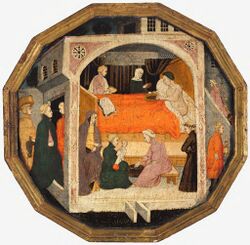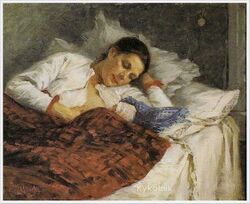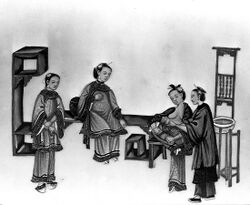Postpartum confinement
Topic: Social
 From HandWiki - Reading time: 8 min
From HandWiki - Reading time: 8 min
Postpartum confinement is a traditional practice following childbirth.[1] Those who follow these customs typically begin immediately after the birth, and the seclusion or special treatment lasts for a culturally variable length: typically for one month or 30 days,[2] 26 days, up to 40 days, two months, or 100 days.[3] [4] This postnatal recuperation can include care practices in regards of "traditional health beliefs, taboos, rituals, and proscriptions."[5] The practice used to be known as "lying-in", which, as the term suggests, centres on bed rest. In some cultures, it may be connected to taboos concerning impurity after childbirth.
Overview
Postpartum confinement refers both to the mother and the baby. Human newborns are so underdeveloped that pediatricians such as Harvey Karp refer to the first three months as the "fourth trimester".[6] The weeks of rest while the mother heals also protect the infant as it adjusts to the world, and both learn the skills of breastfeeding.
Almost all countries have some form of maternity leave. Many countries encourage men to take some paternal leave, but even those that mandate that some of the shared parental leave must be used by the father ("father's quota") acknowledge that the mother needs time off work to recover from the childbirth and deal with the postpartum physiological changes.
A 2016 American book describes the difficulties of documenting those "global grandmotherly customs" but asserts that "like a golden rope connecting women from one generation to the next, the protocol of caring for the new mother by unburdening her of responsibilities and ensuring she rests and eats shows up in wildly diverse places".[7] These customs have been documented in dozens of academic studies, and commonly include support for the new mother (including a release from household chores), rest, special foods to eat (and ones to avoid), specific hygiene practices, and ways of caring for the newborn.[8]
Martha Wolfenstein (psychoanalyst) ({{{2}}}) and Margaret Mead wrote in 1955 that the postpartum period meant a "woman can be cherished and pampered without feeling inadequate or shamed". The 2016 review that quoted them cites customs from around the world, from Biblical times to modern Greece:
From the data it seems that women were housebound for a number of days after the birth and the length of this period of seclusion varied by caste or ethnic group [in Nepal]. This is a phenomenon found across the globe, including in high-income countries in the recent past. The length of time a woman is secluded or rested varied across different countries and the principles underpinning this isolation (to heal vs. being unclean) also seem to differ greatly. After the period of seclusion there is often a ceremony to purify women to publicly accept them back into daily life. The literature supports the concept of a resting – a lengthy lie-in or lying-in period, a period of seclusion, as women need to rest in order to heal, yet it may mean that they are neglected.[9]
Health effects
One meta-review of studies concluded, "There is little consistent evidence that confinement practices reduce postpartum depression."[10]
By region
Asia
China
Postpartum confinement is well-documented in China, where the custom is known as "Sitting the month": 坐月子 "Zuò yuè zi" in Mandarin or 坐月 "Co5 Jyut2" in Cantonese.[11] The period of confinement ranges from 30 to 100 days. Confinement for one month (30 days) is considered "mini confinement" while confinement for three months (100 days) is considered "full confinement". After 100 days, the Hundred Days Banquet (百日宴) is held to celebrate the baby reaching 100 days old.
The Chinese custom of postpartum confinement is documented as far back as the year 960.[12] Women are advised to stay indoors for recovery from the trauma of birth and for feeding the newborn baby. Aspects of traditional Chinese medicine are included, with a special focus on eating foods considered to be nourishing for the body and helping with the production of breastmilk.
In Guangdong and neighboring regions, new mothers are barred from visitors until the baby is 12 days old, marked by a celebration called 'Twelve mornings' (known as 十二朝). From this day onwards, Cantonese families with a new baby usually share their joy through giving away food gifts, while some families mark the occasion by paying tribute to their ancestors.[citation needed]
In ancient China, women of certain ethnic groups in the South would resume work right after birth, and allow the men to practice postpartum confinement instead.[13] (See Couvade).
Aspects of the practice of "sitting the month" continue today, especially in Hong Kong and Taiwan, and mother and baby sometimes spend the month in special clinics.[14] At the end of this period, when the "month is fulfilled" (manyue), the mother receives relatives and friends who bring special foods such as red eggs.[14]
Everyday habits and personal hygiene practices
Traditional in China, the mother and child were kept separate from the rest of the household.[14] The mother was not permitted to bathe, wash her hair, or weep, because these activities were believed to affect the breast milk.[14]
Nowadays, however, new mothers may wash their hair or take a bath or shower infrequently during the postpartum period, but it is claimed to be important to dry their body immediately afterwards with a clean towel and their hair properly using a hair dryer. It is also claimed to be important for women to wrap up warm and minimize the amount of skin exposed, as it was believed that they may catch a cold during this vulnerable time.[citation needed]
Special foods
The custom of confinement advises new mothers to choose energy and protein-rich foods to recover energy levels, help shrink the uterus, and for the perineum to heal. This is also important for the production of breastmilk. Among the traditionally recommended galactogogues were rich porridge, fish soup, and hard-boiled eggs.[14] Sometimes, new mothers only begin to consume special herbal foods after all the lochia is discharged.
A common dish is pork knuckles with ginger and black vinegar as pork knuckles are believed to help replenish calcium levels in women. Ginger is featured in many dishes, as it is believed that it can remove the 'wind' accumulated in the body during pregnancy. Meat-based soup broths are also commonly consumed to provide hydration and added nutrients.
Indian subcontinent
In parts of India it is called jaappa (also transliterated japa); in North India and Pakistan, sawa mahina ("five weeks").
Most traditional Indians follow the 40-day confinement and recuperation period also known as the jaappa (in Hindi). A special diet to facilitate milk production and increase hemoglobin levels is followed. Sex is not allowed during this time. In Hindu culture, this time after childbirth was traditionally considered a period of relative impurity (asaucham), and a period of confinement of 10–40 days (known as purudu) was recommended for the mother and the baby. During this period, she was exempted from usual household chores and religious rites. The father was purified by a ritual bath before visiting the mother in confinement.
In the event of a stillbirth, the period of impurity for both parents was 24 hours.[15]
Many Indian subcultures have their own traditions after birth. This birth period is called Virdi (Marathi), which lasts for 10 days after birth and includes complete abstinence from puja or temple visits.[citation needed]
In Pakistan, postpartum tradition is known as sawa mahina ("five weeks").[16]
Iran
In Persian culture it is called chilla, i.e. "forty days".[17]
Korea
Korean women spend samchil-il (three seven days, 21 days) in confinement, receiving sanhujori (postpartum care). In the past, during the samchil-il period, geumjul (taboo rope) made with saekki and various symbolic objects, such as chili peppers (for a boy) and coal (for a girl), was hung over the gate to denote the childbirth and restrict visitor access.[citation needed]
Thailand
Thailand has various customs. New mothers used to be encouraged to lie in a warm bed near the fire for 30 days, a practice known as yu fai. This has been adapted into a form of Thai massage. Kao krachome is a type of herbal medicine in which the steam from the boiled plants is inhaled. Ya dong involves herbal medicine taken internally. Thai immigrants to Sweden report using the steam bath to heal after childbirth, although the correct ingredients are not easy to find.[18] Thai Australians who had had caesarian sections felt that they did not need to - in fact, ought not to - undergo these rituals.[19]
Europe

The term used in English, now old-fashioned or archaic, was once used to name maternity hospitals, for example the General Lying-In Hospital in London. A 1932 Canadian publication refers to lying-in as ranging from two weeks to two months.[20] These weeks ended with the re-introduction of the mother to the community in the Christian ceremony of the churching of women.
Lying-in features in Christian art, notably Birth of Jesus paintings. One of the gifts presented to the new mother in Renaissance Florence was a desco da parto, a special form of painted tray. Equivalent presents in contemporary culture include baby showers and push presents.[citation needed]
Special foods included caudle, a restorative drink. "Taking caudle" was a metonym for postpartum social visits.[citation needed]
Americas
Latin America
In Latin American countries, it is called la cuarentena ("forty days," a cognate with the English word "quarantine". It is practised in parts of Latin America and amongst in communities in the United States.[21] It is described as "intergenerational family ritual that facilitated adaptation to parenthood", including some paternal role reversal.[22]
See also
- Postpartum care
- Maternal bond and Attachment theory
- Culture and menstruation, including places and times of seclusion
- Impurity after childbirth
- Grandmother hypothesis
- Women-only space
- Wet nurse
- Parental investment in humans
- Sex after childbirth
References
- ↑ Withers, M; Kharazmi, N; Lim, E (January 2018). "Traditional beliefs and practices in pregnancy, childbirth and postpartum: A review of the evidence from Asian countries.". Midwifery 56: 158–170. doi:10.1016/j.midw.2017.10.019. PMID 29132060.
- ↑ Chien, Yeh-Chung; Huang, Ya-Jing; Hsu, Chun-Sen; Chao, Jane C-J; Liu, Jen-Fang (2008). "Effect of Alcohol consumption on Maternal lactation characteristics during 'doing-the-month' ritual". Public Health Nutrition 12 (3): 382–388. doi:10.1017/S1368980008002152. PMID 18426631.
- ↑ "Confinement practices: an overview". http://www.babycenter.com.my/a1021145/confinement-practices-an-overview.
- ↑ "Chinese Postpartum Nannies". https://www.ayiconnection.com/blog/chinese-postpartum-nannies.
- ↑ Tung, Wei-Chen (22 June 2010). "Doing the Month and Asian Cultures: Implications for Health Care". Home Health Care Management & Practice 22 (5): 369–371. doi:10.1177/1084822310367473.
- ↑ "Dr. Karp On Parenting And The Science Of Sleep". National Public Radio. https://www.npr.org/2012/06/24/155426534/dr-karp-on-parenting-and-the-science-of-sleep.
- ↑ Ou, Heng; Amely, Greeven; Belger, Marisa (2016). The First Forty Days: The Essential Art of Nourishing the New Mother. Harry N. Abrams. ISBN 9781617691836.
- ↑ Dennis, Cindy-Lee; Fung, Kenneth; Grigoriadis, Sophie; Robinson, Gail Erlick; Romans, Sarah; Ross, Lori (July 2007). "Traditional Postpartum Practices and Rituals: A Qualitative Systematic Review". Women's Health 3 (4): 487–502. doi:10.2217/17455057.3.4.487. ISSN 1745-5065. PMID 19804024.
- ↑ Sharma, S; van Teijlingen, E; Hundley, V; Angell, C; Simkhada, P (2016). "Dirty and 40 days in the wilderness: Eliciting childbirth and postnatal cultural practices and beliefs in Nepal". BMC Pregnancy Childbirth 16 (1): 147. doi:10.1186/s12884-016-0938-4. PMID 27381177.
- ↑ Wong, Josephine; Fisher, Jane (August 2009). "The role of traditional confinement practices in determining postpartum depression in women in Chinese cultures: A systematic review of the English language evidence". Journal of Affective Disorders 116 (3): 161–169. doi:10.1016/j.jad.2008.11.002. PMID 19135261.
- ↑ Lary, Diana (2022). China's grandmothers : gender, family, and aging from late Qing to twenty-first century. Cambridge, United Kingdom: Cambridge University Press. pp. 49. ISBN 978-1-009-06478-1. OCLC 1292532755. https://www.worldcat.org/oclc/1292532755.
- ↑ Hsu Oh, Leslie (8 January 2017). "I tried the Chinese practice of 'sitting the month' after childbirth". Washington Post. https://www.washingtonpost.com/national/health-science/i-tried-the-chinese-practice-of-sitting-the-month-after-childbirth/2017/01/06/54517ee0-ad0b-11e6-a31b-4b6397e625d0_story.html.
- ↑ 《太平廣記》卷四八三引尉遲樞的《南楚新聞》記載:"南方有獠婦,生子便起。其夫臥床褥,飲食皆如乳婦。"《马可·波罗游记》:"傣族妇女产子,洗后裹以襁褓,产妇立起工作,产妇之夫则抱子卧床四十日";《黔记》卷二:郎慈苗在咸宁州,其俗更异,妇人产子,必夫守房,不逾门户,弥月乃出。产妇则出入耕作,措饭食,以供夫乳儿,日无暇刻。"
- ↑ 14.0 14.1 14.2 14.3 14.4 Lary, Diana (2022). China's grandmothers : gender, family, and aging from late Qing to twenty-first century. Cambridge, United Kingdom: Cambridge University Press. pp. 41. ISBN 978-1-009-06478-1. OCLC 1292532755. https://www.worldcat.org/oclc/1292532755.
- ↑ John Marshall / Jaya Tirtha Charan Dasa. "GUIDE TO RITUAL IMPURITY - What to do at the junctions of birth and death". Hknet.org.nz. http://www.hknet.org.nz/asaucham-info.htm.
- ↑ Qamar, Azher Hameed (27 June 2017). "The Postpartum Tradition of Sawa Mahina in Rural Punjab, Pakistan". Journal of Ethnology and Folkloristics 11 (1): 127–150. doi:10.1515/jef-2017-0008. https://content.sciendo.com/view/journals/jef/11/1/article-p127.xml. Retrieved 6 April 2020.
- ↑ Encyclopedia of women & Islamic cultures. Leiden: Brill. 2003–2007. p. 19. ISBN 90-04-128-190.
- ↑ Pranee C. Lundberg (2007). Pieroni, Andrea; Vandebroek, Ina. eds. Traveling cultures and plants : the ethnobiology and ethnopharmacy of migrations. Berghahn Books. ISBN 9781845456795.
- ↑ Rice, Pranee Liamputtong; Naksook, Charin (October 1998). "Caesarean or vaginal birth: perceptions and experience of Thai women in Australian hospitals" (in en). Australian and New Zealand Journal of Public Health 22 (5): 604–608. doi:10.1111/j.1467-842X.1998.tb01446.x. ISSN 1753-6405. PMID 9744217.
- ↑ Lying in by Jan Nusche quoting The Bride's Book — A Perpetual Guide for the Montreal Bride, published in 1932
- ↑ Tuhus-Dubrow, Rebecca (11 April 2011). "Why Won't This New Mom Wash Her Hair?". http://www.slate.com/articles/double_x/doublex/2011/04/why_wont_this_new_mom_wash_her_hair.html.
- ↑ Niska, Kathleen; Snyder, Mariah; Lia-Hoagberg, Betty (October 1998). "Family Ritual Facilitates Adaptation to Parenthood". Public Health Nursing 15 (5): 329–337. doi:10.1111/j.1525-1446.1998.tb00357.x. PMID 9798420.
Further reading
- The First Forty Days: The Essential Art of Nourishing the New Mother. By Heng Ou, 2016
- Zuo Yuezi: An American Mother's Guide to Chinese Postpartum Recovery. by Guang Ming Whitley
 |
 KSF
KSF



